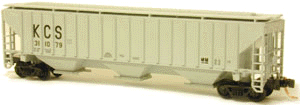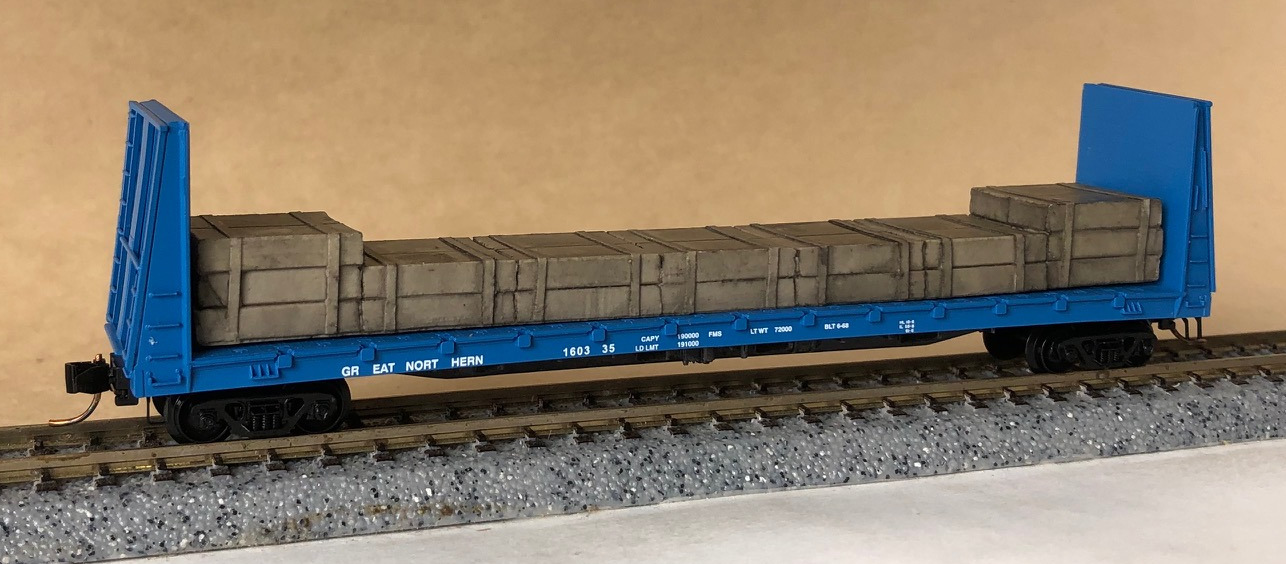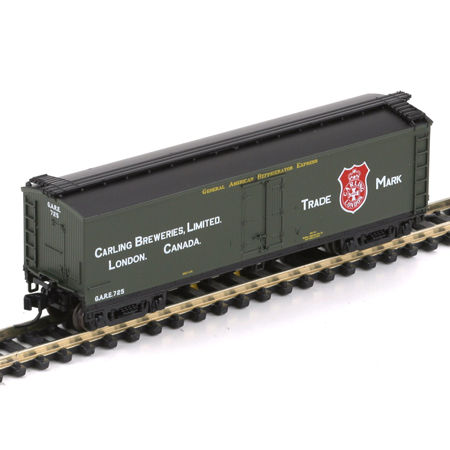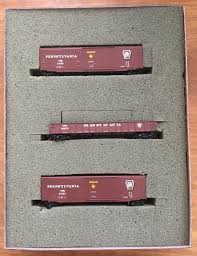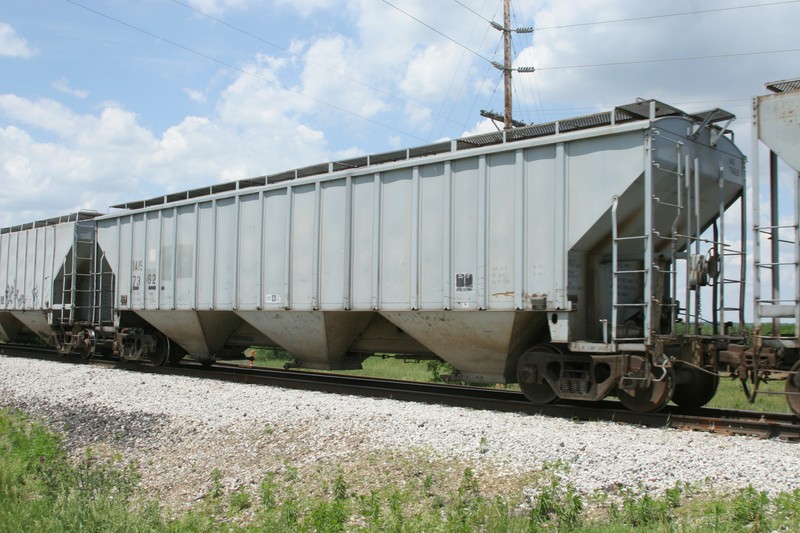Model Information: Precision Masters first released this body style in kit form. Later on, they released the same body as a RTR (Ready-to-Run) model. In 2005, Red Caboose acquired this tooling from PM. Red Caboose released this model in RTR form. The 4740 model can be distinguished from the 4750 model by counting the ribs. The 4740 has 16 ribs and the 4750 has 18 ribs. The ribs on the 4750 are a little chubbier as well.
Fox Valley later acquired all N Scale toolings from Red Caboose and proceeded to re-release an updated version of the 4750 PS-2 Covered Hopper in 2017. The new versions carry MTL body-mounted couplers and low-profile blackened-metal wheels.
Fox Valley later acquired all N Scale toolings from Red Caboose and proceeded to re-release an updated version of the 4750 PS-2 Covered Hopper in 2017. The new versions carry MTL body-mounted couplers and low-profile blackened-metal wheels.
Prototype History: Manufactured by Pullman Standard from 1972 through the 1990's at least, these 4750 Cu. Ft. Hoppers were considered the 'Standard of the Industry' at the time. It is one of the most common freight cars in the rail scene since the late '70's. Features unique to this car include the 18 vertical posts on the car side (19 panel side) and compound curve roof (called by some a clerestory roof).
The 4,740 and 4,750 designs are often mistaken for each other, although the 4,750 has two more panels.
The 4,740 and 4,750 designs are often mistaken for each other, although the 4,750 has two more panels.
Road Name History: KCS began (with a different name) in 1890 under the direction of Arthur Stilwell for the purpose of building a railroad from Kansas City directly south along the Missouri – Kansas, Arkansas – Oklahoma, and Louisiana – Texas borders to the Gulf of Mexico. At the point where the railroad met the Gulf, Stillwell built a port complex and named it after himself, Port Arthur, Texas. Two years later, the company defaulted on a loan, Stilwell was kicked out and they changed the name of the railroad to Kansas City Southern. Stilwell went on to build the Kansas City Mexico & Orient.
The KCS steam fleet was, well, peculiar. They were the only railroad to use 0-6-6-0’s, not as heavy switchers, not as pushers, but as mainline road engines. 2-8-8-0’s were also used for heavy road service with Santa Fe types and Consolidations filling out the freight roster. 11 Pacifics handled the passenger trains. They were odd first in that they had 2 sand domes (rare on passenger power.) Second, they had a high mounted headlight but without a number plate in the middle of the smokebox door, giving the front a strange “faceless” appearance. A few of these Pacifics assigned to the Kansas City – Port Arthur “Flying Crow” were equipped with air horns that sounded like a cawing crow… Really! KCS also had 2 Shays used to muscle cars up and down the 10% grades of many Kansas City industrial spurs. (If you’ve been to Kansas City, you will understand why.) The pinnacle of the fleet was the J class 2-10-4’s, purchased to replace the 0-6-6-0’s in 1937. These were the last Texas types built by Lima and had sleek, jacketed boilers and enclosed cabs.
In 1939, the KCS acquired the Louisiana & Arkansas which ran from Dallas east to Shreveport and then New Orleans. Actually, it was the owners of the L&A that bought the KCS but for charter reasons, the deal was arranged so that KCS took control of L&A. L&A remained semi-autonomous in an SP-Cotton Belt sort of way. This brought the KCS system to over 1,660 miles (between Grand Trunk Western and Delaware & Hudson in relative size.) The L&A image began to fade away in the 1960s but it wasn’t fully merged into KCS until 1992.
Dieselization came primarily from EMD with E’s pulling the Flying Crow and Southern Belle, and F’s in freight service. These were delivered in the classic red, black and yellow with red being dominant on the freight units and yellow on the passenger units. A-B-B-A sets of Erie Builts were also used in freight service but were notorious for breaking knuckles on the hog-back hills of the Ozarks.
Switchers and first generation hood units were delivered in black with white trim (much like Illinois Central) with the name spelled out on the long hood. Hood units and switchers came from EMD, Alco, Baldwin and FM.
In the 1960s, the paint scheme was simplified to a solid red. This became known as Deramus Red after the line’s CEO William Deramus II. Deramus’s son (William III) was head of Chicago Great Western and later M-K-T, both of which used similar reds. While William II was a reasonably adept CEO, his son William III was less successful, at least as far as the railroad was concerned. Under William III, track deteriorated and customers fled, which in turn permitted him to cut more service and staff. Fewer, longer trains were dispatched. Meanwhile William III was pouring available cash into diversifying into less regulated industries. By the 1970s, KCS faced a triple threat. Track condition was at an all time low, the first generation diesels were wearing out and tonnage was increasing. A new CEO began to turn the railroad around. The red paint scheme was dumped for white with red lettering. Grain moving down from Kansas City was joined by petro-chemicals moving up from the coast. Powder River Coal joined the mix during this period.
KCS’s diversified holdings, including the Janus Fund, made KCS ripe for takeover. In 1985, leftist fundraiser George Soros attempted a hostile takeover but was foiled first by a real estate developer and then by a Deramus successor who had since moved to Hallmark Cards and then bought a large block of KCS stock.
Now a rousing success, KCS spun off Janus and other holdings and kept the railroad because that is where the REAL money was! In 2006, the Southern Belle red, yellow, and black paint scheme was re-introduced. A version of it was even applied to some new KCS freight cars (KCS freight cars had been notorious dull for decades with few having anything more than reporting marks to trumpet their owner.)
The KCS steam fleet was, well, peculiar. They were the only railroad to use 0-6-6-0’s, not as heavy switchers, not as pushers, but as mainline road engines. 2-8-8-0’s were also used for heavy road service with Santa Fe types and Consolidations filling out the freight roster. 11 Pacifics handled the passenger trains. They were odd first in that they had 2 sand domes (rare on passenger power.) Second, they had a high mounted headlight but without a number plate in the middle of the smokebox door, giving the front a strange “faceless” appearance. A few of these Pacifics assigned to the Kansas City – Port Arthur “Flying Crow” were equipped with air horns that sounded like a cawing crow… Really! KCS also had 2 Shays used to muscle cars up and down the 10% grades of many Kansas City industrial spurs. (If you’ve been to Kansas City, you will understand why.) The pinnacle of the fleet was the J class 2-10-4’s, purchased to replace the 0-6-6-0’s in 1937. These were the last Texas types built by Lima and had sleek, jacketed boilers and enclosed cabs.
In 1939, the KCS acquired the Louisiana & Arkansas which ran from Dallas east to Shreveport and then New Orleans. Actually, it was the owners of the L&A that bought the KCS but for charter reasons, the deal was arranged so that KCS took control of L&A. L&A remained semi-autonomous in an SP-Cotton Belt sort of way. This brought the KCS system to over 1,660 miles (between Grand Trunk Western and Delaware & Hudson in relative size.) The L&A image began to fade away in the 1960s but it wasn’t fully merged into KCS until 1992.
Dieselization came primarily from EMD with E’s pulling the Flying Crow and Southern Belle, and F’s in freight service. These were delivered in the classic red, black and yellow with red being dominant on the freight units and yellow on the passenger units. A-B-B-A sets of Erie Builts were also used in freight service but were notorious for breaking knuckles on the hog-back hills of the Ozarks.
Switchers and first generation hood units were delivered in black with white trim (much like Illinois Central) with the name spelled out on the long hood. Hood units and switchers came from EMD, Alco, Baldwin and FM.
In the 1960s, the paint scheme was simplified to a solid red. This became known as Deramus Red after the line’s CEO William Deramus II. Deramus’s son (William III) was head of Chicago Great Western and later M-K-T, both of which used similar reds. While William II was a reasonably adept CEO, his son William III was less successful, at least as far as the railroad was concerned. Under William III, track deteriorated and customers fled, which in turn permitted him to cut more service and staff. Fewer, longer trains were dispatched. Meanwhile William III was pouring available cash into diversifying into less regulated industries. By the 1970s, KCS faced a triple threat. Track condition was at an all time low, the first generation diesels were wearing out and tonnage was increasing. A new CEO began to turn the railroad around. The red paint scheme was dumped for white with red lettering. Grain moving down from Kansas City was joined by petro-chemicals moving up from the coast. Powder River Coal joined the mix during this period.
KCS’s diversified holdings, including the Janus Fund, made KCS ripe for takeover. In 1985, leftist fundraiser George Soros attempted a hostile takeover but was foiled first by a real estate developer and then by a Deramus successor who had since moved to Hallmark Cards and then bought a large block of KCS stock.
Now a rousing success, KCS spun off Janus and other holdings and kept the railroad because that is where the REAL money was! In 2006, the Southern Belle red, yellow, and black paint scheme was re-introduced. A version of it was even applied to some new KCS freight cars (KCS freight cars had been notorious dull for decades with few having anything more than reporting marks to trumpet their owner.)
Brand/Importer Information:  Originally Red Caboose was a manufacturer of HO and N Scale model railroading items. It was located in Mead, Colorado, and was founded in 1990 by Leon Fairbanks.
Red Caboose manufactured highly accurate, well detailed N, HO, and O Scale freight cars and locomotives.
Originally Red Caboose was a manufacturer of HO and N Scale model railroading items. It was located in Mead, Colorado, and was founded in 1990 by Leon Fairbanks.
Red Caboose manufactured highly accurate, well detailed N, HO, and O Scale freight cars and locomotives.
Red Caboose closed its doors in January of 2015. Red Caboose N Scale has been sold to Fox Valley Models and HO was sold to InterMountain Railway. Many of the Red Caboose toolings have seen re-releases from Fox Valley since the acquisition. We just wish they would clean up the underframes. Red Caboose always went light on the details where they thought people wouldn't look.

Red Caboose closed its doors in January of 2015. Red Caboose N Scale has been sold to Fox Valley Models and HO was sold to InterMountain Railway. Many of the Red Caboose toolings have seen re-releases from Fox Valley since the acquisition. We just wish they would clean up the underframes. Red Caboose always went light on the details where they thought people wouldn't look.
Manufacturer Information: While they were in business, Red Caboose split its production runs between the US and China. Which models were produced where was a function of which body style and which run. Furthermore, which Chinese company was used for production is something we would love to find out.
Item created by: CNW400 on 2022-05-03 14:58:33
If you see errors or missing data in this entry, please feel free to log in and edit it. Anyone with a Gmail account can log in instantly.
If you see errors or missing data in this entry, please feel free to log in and edit it. Anyone with a Gmail account can log in instantly.


